We, like you, work on Linkedin every day, so it’s worth knowing its history to better detect algorithm changes. As you know, we produce heated and secure fake Linkedin profiles to help you bypass the limitations that Linkedin imposes. And all this brings us to the secrets of this famous medium.
Discover the evolution of LinkedIn, the social network founded in 2003 by Reid Hoffman and Allen Blue. Now a must-have in the professional world, LinkedIn is revolutionizing the way professionals connect and interact. With millions of members worldwide, this medium has become essential for professionals, businesses and digital agencies, offering employment, networking and collaboration opportunities.
From its humble beginnings to its acquisition by Microsoft, LinkedIn has constantly evolved to meet the needs of its users. Whether you’re in Paris or elsewhere, LinkedIn has probably had an impact on your professional life. Discover how LinkedIn has evolved from an innovative idea to a global platform, becoming an indispensable tool.
The beginnings of LinkedIn
The original idea and the co-founders
The LinkedIn adventure began thanks to the inspiration of its co-founders: Reid Hoffman, Allen Blue, Konstantin Guericke, Eric Ly, and Jean-Luc Vaillant. Reid Hoffman, with a wealth of experience in the world of startups, notably as COO of PayPal, was the cornerstone of this ambitious project. The aim was to create a platform for networking, exchanging information and seizing business opportunities.
Allen Blue, with its expertise in design and theater, injected a dose of innovation and creativity into the project. The founders, brought together by shared networks, envisioned a tool to optimize the management of professional networks in an efficient way.
A budding project in the garage
The LinkedIn project was born in Reid Hoffman’s living room in Palo Alto, California, in December 2002, which served as his first office. This was a time of intense creativity and a willingness to take risks – indispensable qualities for entrepreneurs.
The first few months were dedicated to building and developing the medium, with an emphasis on building a robust and trusted network. The co-founders worked tirelessly to lay the foundations of what was to become one of the world’s most influential networking platforms.
The beginnings of LinkedIn
The original idea and the co-founders
The LinkedIn adventure began thanks to the inspiration of its co-founders: Reid Hoffman, Allen Blue, Konstantin Guericke, Eric Ly, and Jean-Luc Vaillant.
Reid Hoffman, with a wealth of experience in the world of startups, notably as COO of PayPal, was the cornerstone of this ambitious project. The aim was to create a platform for networking, exchanging information and seizing business opportunities.
Allen Blue, with its expertise in design and theater, injected a dose of innovation and creativity into the project. The founders, brought together by shared networks, envisioned a tool to optimize the management of professional networks in an efficient way.
A budding project in the garage
The LinkedIn project was born in Reid Hoffman’s living room in Palo Alto, California, in December 2002, which served as his first office.
This was a time of intense creativity and a willingness to take risks – indispensable qualities for entrepreneurs.
The first few months were dedicated to building and developing the medium, with an emphasis on building a robust and trusted network.
The co-founders worked tirelessly to lay the foundations of what was to become one of the world’s most influential networking platforms.
The official birth of LinkedIn
The launch in 2003
May 5, 2003 is a key date in the history of LinkedIn, marking its official launch.
This day initiated a revolution in the way professionals communicate and connect online.
Barely a month later, LinkedIn already had 4,500 members, mainly contacts of the co-founders.
This modest start laid the foundations for spectacular expansion.
Invitations to join the network, sent out by the co-founders themselves, formed an initial circle of committed users.
First steps and features
In the beginning, LinkedIn offered basic but essential functions for professionals, enabling them to create profiles, search and connect with other professionals, and post job offers.
These early functions, such as adding contacts by importing address books, contributed to the rapid growth of the network.
LinkedIn also introduced the ability to send invitations to expand its network, facilitating rapid expansion of the user community.
Growth and milestones
From 0 to 1 million users
LinkedIn was launched in May 2003 and rapidly expanded its membership.
By December 2003, the social network had 81,000 members, and this growth accelerated in 2004.
In April 2004, LinkedIn celebrated its 500,000th member, and in August it passed the million-user mark.
This meteoric growth was stimulated by the introduction of innovative functions, such as adding contacts and invitations, boosting the network’s expansion.
Internationalization and network expansion
LinkedIn’s expansion didn’t stop at American borders.
In 2008, it inaugurated its first international office in London and launched versions in Spanish and French, marking the beginning of its internationalization.
This international opening has been a strategic pivot for LinkedIn, enabling it to establish itself as a global professional network.
This move has attracted millions more users around the world, consolidating LinkedIn’s leadership position in the professional social networking sector.
Initial public offering
In May 2011, LinkedIn reached a major milestone by going public.
Its listing on the New York Stock Exchange was a key moment, opening a new chapter in the company’s history.
This step enabled LinkedIn to raise significant funds, supporting its continued growth and future development.
It also enhanced LinkedIn’s credibility and visibility, attracting more users and investors.
Innovations and development at LinkedIn
Enhanced functionality and user experience
Over the years, LinkedIn has continually enhanced its functions and enriched the user experience.
A major innovation has been the introduction of the search bar, making it easier to find contacts, companies and job opportunities.
In addition, the user interface has benefited from regular updates, making navigation more intuitive and fluid for the millions of users.
Messaging and notification functions have also been optimized, enabling more effective communication within networks.
These improvements have played a key role in increasing user engagement and the perceived value of the medium.
The introduction of company pages and job offers
The introduction of company pages represents another significant step forward, offering companies the opportunity to create personalized profiles.
This enables them to highlight their culture, values and job opportunities, making it easier to find talent and communicate with potential candidates.
At the same time, the Job Postings feature was developed, offering companies a way to post ads and candidates a way to search for opportunities in a targeted way.
These functions have made LinkedIn an indispensable tool for recruiting and job hunting, consolidating its position as a leader among social networks.
The advent of content and the evolution of algorithms
LinkedIn has also focused on user-generated content, with the introduction of features such as publications and stories.
This has encouraged the creation of a more engaging and interactive community, where users can share and learn from each other.
LinkedIn’s algorithms have evolved to offer improved targeting and personalization of content, increasing user engagement and satisfaction.
This evolution has also enabled companies to reach their target audience more effectively, presenting their content and job offers to the most relevant users.
Microsoft acquisition and new horizons
Reasons for the acquisition and changes made
In June 2016, the multinational acquired LinkedIn for $26.2 billion, marking one of the most significant transactions in the history of technology.
The aim of this strategic maneuver was to merge the strengths of LinkedIn, the largest pro social network, with those of Microsoft, an undisputed leader in productivity software and cloud services.
The ambition was to consolidate the multinational’s position in the corporate market, while opening up new avenues for LinkedIn users.
The acquisition enabled LinkedIn to preserve its unique identity and culture, under the continued leadership of Jeff Weiner as CEO, reporting to Microsoft CEO Satya Nadella.
This organization facilitated a smooth integration and ensured LinkedIn’s operational autonomy.
Integration with Microsoft and impact on development
The harmonization of LinkedIn with the multinational’s products proved to be a decisive aspect of this acquisition.
It enabled LinkedIn users to benefit from features integrated into the multinational’s applications, such as the incorporation of LinkedIn into Outlook and the Office suite, and the use of LinkedIn Learning (previously Lynda) in the Office 365 ecosystem.
These integrations have not only enhanced the user experience, but also strengthened the connection between Microsoft and LinkedIn productivity tools.
In addition, collaboration with the multinational’s cloud services, such as Azure, has offered LinkedIn access to cutting-edge technological resources, fostering its future growth and evolution.
New functions and future direction
Since its acquisition, LinkedIn has continued to innovate by launching new functions.
A key area of development has been the adoption of artificial intelligence (AI) to optimize recruitment and advertising processes.
For example, the introduction of AI-based advertising content creation tools has enabled companies to generate more effective advertising campaigns.
The media company has also focused on improving the user experience, offering regular updates to make LinkedIn more intuitive and captivating.
Notification and messaging functions have been enhanced, and new search and recommendation tools have been developed to help users discover relevant job opportunities and contacts more easily.
LinkedIn today: an assessment
Number of users and impact on the job market
LinkedIn currently boasts over a billion users worldwide, making it one of the world’s leading professional social networks.
Its influence on the job market is considerable: every minute, eight people land a job, while almost 49 million people use it to actively seek professional opportunities.
What’s more, 87% of recruiters rely on LinkedIn to source and evaluate candidates, underlining the importance of the platform in today’s recruitment processes.
Not to mention the implementation of recruitment campaigns thanks to the advent of growth hiring.
The growing trend of remote work searches on LinkedIn reflects contemporary developments in the job market, confirming LinkedIn’s central position in the field of professional connectivity and recruitment.
The platform as a professional networking tool
LinkedIn has established itself as an essential networking tool, facilitating contact with colleagues, business partners and opinion leaders.
This network encourages the sharing of ideas and opportunities for collaboration.
Members who actively interact with others increase their engagement by a factor of four, while those who regularly share content double their growth on the medium.
With 64 million decision-makers present on LinkedIn, the medium becomes an ideal terrain for companies and pros keen to influence business decisions.
It also offers invaluable tools for personal branding and social selling, amplifying online visibility and broadening career horizons.
Finally, LinkedIn’s story can be summed up as a remarkable trajectory of growth, innovation and transformation.
From its modest beginnings in 2003 to its acquisition by Microsoft in 2016, LinkedIn has evolved to become a must-have tool across the globe.
With now over a billion users, LinkedIn occupies a central position in the job market, facilitating connections, recruitment, and career development.
To maximize the benefits offered by this platform, it’s essential to actively engage, share relevant content and participate in exchanges within your network.
All the tips you need to maximize your impact on Linkedin are in this blog, so don’t hesitate to read our articles 🙂





